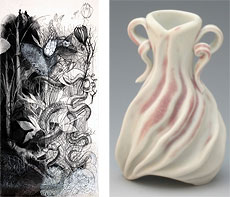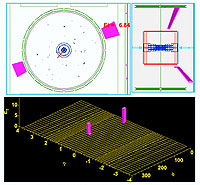|
Have a safe day!
Thursday, June 23
2:30 p.m.
Theoretical Physics Seminar - Curia II
Speaker: Christopher Vermilion, University of Washington
Title: The GenEvA Event Generator: Coming Soon to a Collider Near You
3:30 p.m.
DIRECTOR'S COFFEE BREAK - 2nd Flr X-Over
THERE WILL BE NO ACCELERATOR PHYSICS AND TECHNOLOGY
SEMINAR TODAY
Friday, June 24
3:30 p.m.
DIRECTOR'S COFFEE BREAK - 2nd Flr X-Over
4 p.m.
Joint Experimental-Theoretical Physics Seminar - One West
Speaker: Lisa Whitehead, Brookhaven National Laboratory
Title: Recent Results from MINOS
Click here for NALCAL,
a weekly calendar with links to additional information.
Upcoming conferences |
|
Thursday, June 23
- Breakfast: Apple sticks
- Tomato Florentine
- BBQ pork sandwich
- Smart cuisine: Kielbasa & sauerkraut
- Smart cuisine: Chicken marsala
- Smoked turkey melt
- Assorted sliced pizza
- SW chicken salad w/ roasted corn salsa
Wilson Hall Cafe Menu
|
|
Friday, June 24
Closed
Wednesday, June 29
- Szechuan spicy pork & noodle salad
- Carrot-cucumber relish
- Lemon cheesecake w/ gingersnap crust
Chez Leon Menu
Call x3524 to make your reservation. |
|
On-site volunteer cleanup opportunity today
Help keep Fermilab's site clean. Join the Third Thursday Lunchtime Cleanup crew to clean areas of the site from 11:45 a.m. to 1:30 p.m. today. Meet at the east ground floor entrance of Wilson Hall for transportation to the cleanup site. Cleanup gear will be provided. Hot dogs and refreshments will be served.
Contact Jeannette Olah via email or at x3303 for more information or to sign up.
|
British Empire honors MINOS scientist Jenny Thomas
 |
|
Jenny Thomas
|
Neutrino scientist Jenny Thomas, co-spokesperson of Fermilab’s MINOS experiment and professor at University College London, was named a Commander of the Order of the British Empire (CBE) for her services to science.
The Order of the British Empire honors those who have performed charitable work, public service or distinguished service to the arts and sciences. The honors were created by King George V in 1917, and are given twice a year: on New Year’s Day and on the Queen’s birthday on June 11.
This year, Thomas is among 965 recipients of the British honors, 95 of whom have been named CBE. Other honorees include Nobel Prize winner Robert Edwards, who pioneered the field of in vitro fertilization, actor Colin Firth and singer and songwriter Bryan Ferry.
Thomas received a Ph.D. in particle physics from Oxford University in 1983. She began work on MINOS as a research officer at Oxford University in 1994.
At MINOS, Thomas and other collaborators study the phenomena of neutrinos changing from one type into another. Neutrinos, which exist in three flavors, or types, were once believed to be massless. Now, after 12 years of experimentation, scientists understand neutrinos to have a very small but non-zero mass.
Their small mass makes it impossible to weigh them in the laboratory. Instead, scientists watch them change, or oscillate, between the three different flavors across long distances, such as between the MINOS near detector at Fermilab and the experiment’s far detector in the Soudan Mine in Minnesota. Neutrino oscillations reveal information about their masses.
Thomas was part of a collaboration that made the world’s most precise measurement of the parameters that govern neutrino and antineutrino oscillations.
Thomas also spent several years serving as chair of the scientific committee that advised the United Kingdom’s Science & Technology Facilities Council on budgetary matters.
Thomas said she was taken aback when she first heard about the award and will look forward to receiving the honor, direct from the Queen herself.
“I think my mum is the most excited about it,” Thomas said.
Thomas will be honored later this year at a ceremony at Buckingham Palace.
— Christine Herman
|
TIAA-CREF seminars, counseling sessions available
Fermilab will bring TIAA-CREF representatives on site this week and next to inform employees about their retirement options.
On June 23 and June 28,a TIAA -CREF representative will host an informational retirement seminar at Fermilab. The seminar, titled: "Your Retirement Income Options," will provide a comprehensive view of all income options offered by TIAA-CREF. Ken Wolinski will present the seminar at 2:30 p.m. on June 23 in The Big Room, a conference room in building 327 near CDF (view map). Michael Mitchell will present the same seminar at 2 p.m. on June 28 in One West. Learn more
TIAA-CREF representatives will also host on site one-on-one retirement counseling sessions on Tuesday, June 28, and Wednesday, June 29, for employees who are considering participating in the SSVSP. Chris Stephens will host sessions from 8:30 a.m. to 4:30 p.m. on both days in 1570, an office on the 15th floor, west side of Wilson Hall. Contact TIAA-CREF at 1-800-732-8353 for an appointment.
For more information on any resources or services related to Fermilab’s self-select voluntary separation program, please see the SSVSP website.
|
“Natural Elements” exhibit to showcase nature-inspired art
 |
| The Fermilab Art Gallery exhibit, “Natural Elements,” features work from Chicagoland artists Karen Brown and Roberta Polfus. At left, "Snakes, Grass" by Brown; at right, "White & pink porcelain lady vase with handles" by Polfus. |
The Fermilab Art Gallery is a place where art and science converge.
Members of the Fermilab community are invited to a reception from 5 to 7 p.m. on Friday, June 24, at the Fermilab Art Gallery in Wilson Hall. Attendees can meet the artists and enjoy a time of mingling over hors d’oeuvres.
The show, “Natural Elements,” will remain on display until Aug. 24, featuring work from Chicagoland artists Karen Brown and Roberta Polfus.
Georgia Schwender, Fermilab’s visual arts coordinator, selected these particular artists for the gallery because of how they use different media to portray similar elements of nature.
Brown uses charcoal, watercolor and colored pencils on cotton-rag paper scrolls to create nature-inspired pieces, with both real and imagined subjects including reptiles, underwater creatures and a variety of plants.
“I love being a physical thing in a world of tangible stuff, all held together by structures that are invisible to me,” Brown said. “Drawings are living things. They grow at their own pace-- some grow fast, others not so much.”
Polfus sculpts and carves a type of white English porcelain known as grolleg porcelain. Her pieces are either wheel-thrown, hand-built or a combination, and take the form of teapots, vases and other vessels that “fit and feel good in the hand,” according to her artist’s statement.
“My inspiration, I would say, is the natural world and things around me… not just things growing, but insects, birds, all kinds of different things,” Polfus said. “I would say it’s more instinctual and sometimes I get lost in the pieces.”
Schwender, along with a committee of volunteers, organizes five or six art shows each year, featuring a variety of genres, including photography, sculpture, multimedia, drawing and painting.
Art has a long history at Fermilab. The late Robert Wilson, former Fermilab director, was both an artist and a physicist.
“He always felt like art should be a part of the workplace to inspire and soothe the employees,” Schwender said. “We encourage everyone to come out for a chance to mingle and enjoy the professionalism of the works on display.”
— Christine Herman
|
|
New light on the strong interaction
 |
| A collision recorded by CDF with two high-energy photons
produced and no other particles. |
When a proton and an antiproton collide at very high energy in Fermilab's Tevatron, about 25 percent of the time they just scatter away from the point of collision at a very small angle without losing any energy. We call that elastic scattering. This can happen in two ways: via the electromagnetic force (a photon is exchanged)
or by the strong force if the protons overlap. In the other 75 percent of cases some of the energy of the collision goes into creating new strongly interacting particles or hadrons, such as π mesons.
The CDF collaboration has found (see Exclusive Diphoton Production)
that there is a third class of collisions. In this class, the particles lose a small fraction (less than about 1 percent) of their energy, but no hadrons are created. The collision only creates a pair of energetic photons, or gamma rays, out of the lost energy. This is the first observation of this process (see figure).
The new photon pair creation process involves both the strong
and the electromagnetic interactions. Scientists predicted this process, but it is hard to calculate.
Gluons are the quanta of the strong force binding quarks inside protons. When two gluons collide they can create a quark-antiquark pair that immediately converts into a pair of photons. These nearly always appear together with many other particles. It rarely happens that another gluon is exchanged in such a way that no hadrons are created. The measured very small rate at which such isolated photon pairs are created agrees with the Standard Model expectation.
This rate is about one in 25 billion collisions. This result was presented at a recent Fermilab seminar.
— edited by Andy Beretvas
 |
| These physicists were responsible for this analysis:
From left: Mike Albrow, Fermilab; Erik Brücken, Helsinki, Finland; and Risto Orava, Helsinki,
Finland. |
|
TAUWER aims for cosmic heights
| The TAUWER experiment looks at particle showers that originate from tau neutrinos that take short paths through the earth (inset). An ideal site to observe these events is a mountain bowl. Image courtesy of Maurizio Iori. |
The origin of ultra-high-energy cosmic rays is a question that makes it onto many top-unsolved-problems-in-physics lists.
The math says that these particles, which carry in excess of 1019 electron volts, or eV, from somewhere in outer space, are far too energetic not to have interacted themselves out of existence before reaching the earth. And yet every year scientists see evidence in the earth’s atmosphere of a handful of these particles, which have several million times the energy of the protons being collided at the Large Hadron Collider.
Scientists are proposing a new experiment, called TAUWER, that would look to tau neutrinos to remove some of the mystery from these strange, over-stimulated cosmic rays.
“The question is, how do they get this energy?” says James Russ, TAUWER collaborator and professor of physics at Carnegie Mellon University. “We don’t know what the mechanism is.”
One idea for the mechanism is a rapid rebounding between plasma shock waves. In places such as those near black holes, where charged matter builds to extreme densities, protons may be ricocheting back and forth between shock wave fronts, accelerating and gathering energy over billions of years. Then one day the proton may escape and come to earth in the form of an ultra-high-energy cosmic ray or UHECR.
If these UHECRs are indeed protons escaped from star systems, they’ll reveal their existence, through a series of interactions, by producing ultra-high-energy neutrinos, neutrinos with energies greater than 1016 eV—over a billion times more energetic than those produced by supernovas.
TAUWER detectors would examine the particle showers brought on by these neutrinos’ interaction with the earth. The resulting energy measurements of the tau neutrinos could give scientists information about their conjectured parents, the UHECR protons.
Read more
— Leah Hesla |
|
June 20-21
- Four stores provided 44.25 hours of luminosity
- NuMI personnel conducted target scans
- Booster beam tripped off when an RF equipment rack lost its power
- Proton Source beam suffered from Booster west anode power supply trips
- Interlock technicians began conducting safety system tests of the accelerators
- Tevatron personnel conducted luminosity leveling studies
- NuMI reports possibly finding the cause of its helium leak
Read the Current Accelerator Update
Read the Early Bird Report
View the Tevatron Luminosity Charts |
|